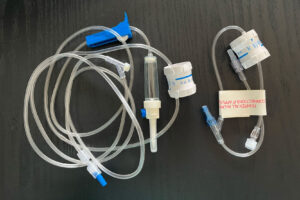
Averting Methanol Disasters: Essential Evaluation and Treatment Tips
- Posted by Mike Shertz MD/18D
- Categories Travel Medicine
Toxic alcohol ingestions are extremely fatal if not treated properly but are easily managed once the diagnosis is made.
Researched and written by Mike Shertz, MD/18D, not AI
🕖 Reading Time, 4 minutes
Methanol, sometimes known as wood alcohol, is most commonly found in windshield washer fluid. Outbreaks of unintentional ingestion in “tainted” beverages have occurred, mostly in low-resource countries. This can sometimes happen when methanol is produced unintentionally during illegal or poorly controlled alcohol manufacture. Unfortunately, six tourists died recently in Laos from unexpected methanol exposure.

Pro Travel tip: Maybe don’t drink the free voka and whiskey in your $7 per night hostel.
Read the NPR Article: A string of deaths in Laos tied to tainted alcohol has raised alarm around the world and renewed concerns about methanol in alcoholic drinks.
Methanol and other “toxic alcohols,” like ethylene glycol (in antifreeze), cause death from the body’s metabolism of the toxic alcohol into a chemical that damages body organs. In the case of methanol, the enzyme alcohol dehydrogenase (ADH) converts it into formic acid. The methanol itself isn’t the problem. It’s the body’s conversion of it into something toxic that causes blindness and fatalities.
More typically, alcohol dehydrogenase breaks down ethyl alcohol into non-toxic metabolites. Because ethyl alcohol out-competes (10X) methanol for access to ADH, if you ingest ethyl alcohol and methanol together, the methanol does not get turned into formic acid. The body eventually breaks it down in other non toxic ways.
The problem is that you need a reasonable amount of ethyl alcohol to keep the ADH busy and away from methanol. Specifically, >100 mg / dL, or a blood alcohol of 0.1 for the duration of the presence of methanol in the body.
The hospital where I work used ethyl alcohol drips in toxic alcohol exposures when I first started there in the early 2000’s. Typically, significant toxic alcohol exposures are treated with dialysis to remove the substance. Now, there are also medications (fomepizole) that prevent the conversion of toxic alcohols into toxic metabolites.
Since most average drinkers’ bodies break down ethyl alcohol at a rate of about 10 – 20 ml / dL / hour, to try and protect the methanol-poisoned patient with ethyl alcohol will require continuously providing them enough alcohol to be intoxicated for the duration of time it takes the body to otherwise break methanol down. Methanol can have a 30-to-50-hour half-life.1
As you would anticipate, vomiting can be a significant limiter in the ability to use this modality, which was why it was given IV. No, I don’t think you should give someone IV vodka instead. Dosing is going to be difficult; it has chemical contaminants in it besides ethyl alcohol, it is damaging to veins, and it may not really be sterile at typical proofs.
One problem with making the diagnosis of methanol or any toxic alcohol exposure is: How do you know the intoxicated appearing person ingested a toxic alcohol? All of the toxic alcohols cause intoxication like ethyl alcohol. Although they typically appear more intoxicated than the usual ethyl alcohol intoxicated individual, without a blood alcohol level, you don’t really know if it’s a toxic alcohol, some other sedating drug combined with alcohol, or they’re just really drunk. Even in resource-rich hospitals, a toxic alcohol blood panel takes hours to days to obtain results.
Methanol ingestion often presents with nausea, vomiting, epigastric pain, and altered mental status. In a study of 22 methanol-poisoned patients arriving alive to an ED in Saudi Arabia, 74% had vomiting, 44% were altered, 39% had impaired vision, 36% were tachycardiac, 13% seized, and 9% were hypotensive. The overall fatality rate was 17.4%, but other “outbreaks” have had death rates up to 48%.2
Ultimately, vision impairment occurred in 58% of survivors.2
Formic acid, the toxic metabolite of methanol, causes optic nerve damage; some have recommended asking those potentially exposed about “snowy” or abnormal vision.
Is there a role for oral ethyl alcohol treatment in the suspected methanol-exposed person in a low-resource setting? Yes, but likely only for several hours. As an example, getting someone to a blood alcohol of 200 mg / dL would protect them for about four hours.
- There would be no real way to maintain them at a protective level orally (100 mg / dL) for several days until the methanol was broken down.
- Even with a nasogastric tube and slow dripping ethyl alcohol into them, they likely won’t tolerate the prolonged intoxication without vomiting, risk of aspiration, and altered mental status.
- Besides, your drunk friend is hard enough to be around when you’re sober. Now image taking care of them, intoxicated, for days….
Ultimately, toxic alcohol ingestions are extremely fatal if not treated properly but are easily managed once the diagnosis is made.
References:
1Palatnick W, Redman LW, Sitar DS, Tenenbein M. Methanol half-life during ethanol administration: implications for management of methanol poisoning. Ann Emerg Med. 1995 Aug;26(2):202-7. doi: 10.1016/s0196-0644(95)70152-4. PMID: 7618784.
2Alhusain F, Alshalhoub M, Homaid MB, Esba LCA, Alghafees M, Al Deeb M. Clinical presentation and management of methanol poisoning outbreaks in Riyadh, Saudi Arabia: a retrospective analysis. BMC Emerg Med. 2024 Apr 16;24(1):64. doi: 10.1186/s12873-024-00976-1. PMID: 38627622; PMCID: PMC11020920.
Dr. Mike Shertz is the Owner and Lead Instructor at Crisis Medicine. Dr. Shertz is a dual-boarded Emergency Medicine and EMS physician, having spent over 30 years gaining the experience and insight to create and provide his comprehensive, science-informed, training to better prepare everyday citizens, law enforcement, EMS, and the military to manage casualties and wounded in high-risk environments. Drawing on his prior experience as an Army Special Forces medic (18D), two decades as an armed, embedded tactical medic on a regional SWAT team, and as a Fire Service and EMS medical director.
Using a combination of current and historical events, Dr. Shertz’s lectures include relevant, illustrative photos, as well as hands-on demonstrations to demystify the how, why, when to use each emergency medical procedure you need to become a Force Multiplier for Good.


